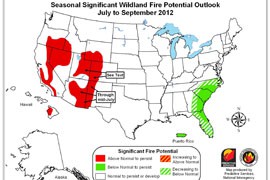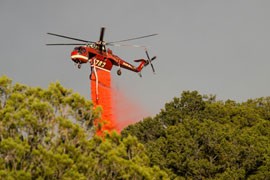Cronkite News has moved to a new home at cronkitenews.azpbs.org. Use this site to search archives from 2011 to May 2015. You can search the new site for current stories.
NOAA: Warmer, drier winter and spring raise likelihood for summer wildfires
WASHINGTON – Arizona is one of several Western states with a higher-than-normal likelihood for large wildfires this summer based on unseasonably dry weather conditions, according to new data from the National Oceanic and Atmospheric Association.
NOAA’s summer outlook, which agencies use to determine the best placement of firefighting resources, said Thursday that recent dry months have led to dry vegetation, which fuels fires.
“This past winter and spring has been drier than normal and warmer than normal across the Southwest,” said Roger Lamoni, the fire weather program manager for the Western region of the National Weather Service. “This year the vegetation is running about four to six weeks early in drying out.”
But conditions can change weekly, depending on the degree of drought, temperatures and humidity, he said.
“If any fire started, the combination of the weather and the wind, combined with the dried vegetation, would make the fire more difficult to fight,” Lamoni said of the current conditions.
And while the government sees the possibility for more fires, officials caution that that does not necessarily mean worse fires. That sort of predicting is beyond what forecasters say they can accurately do.
“People are asking if we’re going to have more Las Conchas and Wallow fires, but that’s not a question we answer,” said Chuck Maxwell, a meteorologist for Predictive Services. “We expect a higher-than-normal probability of more-than-typical large fire activity, but we’re looking at if the fire will go over 200 acres, not 200,000.”
Maxwell said Thursday’s report is used to identify regions with lower-than-normal wildfire potential from July through September so that air tankers, firefighters and other resources can be moved to regions where a fire is more likely to occur.
Shifting the resources now enhances the response when fire does break out, Lamoni said.
“Ultimately, the goal is to have the firefighting resources already nearby, so that when a fire starts, they have the people and equipment to fight it effectively,” he said.
Carrie Templin, public affairs specialist for the Bureau of Land Management office in Arizona, said it is critical to be able to mobilize resources between agencies and regions – from areas like Florida and Georgia to high-potential areas in Arizona, Colorado or New Mexico.
“We share resources between agencies,” Templin said. “So if you like staying where you’re at, don’t become a firefighter, because you’ll never know where you’re going to be.”
The Southwest Coordination Center in Albuquerque, N.M., has already brought in outside resources, “knowing that we probably would exceed our capabilities to respond with our own resources,” said spokesman Dave Killebrew.
He said that, in terms of number of fires and acres burned, the fire season so far this year has been “fairly typical” compared to the last 10 to 15 years.
“It appears it’s worse than normal but it’s not, simply because of the two or three large-profile fires” across the West so far, Killebrew said.
Templin said it is almost impossible to predict a fire season’s severity, because severity can reflect so many things.
“We see situations in Colorado where homes were lost, or in New Mexico, whether that’s because we have more fires or because we have more people living in areas they weren’t before,” she said.
Maxwell said that while officials can measure the size of a fire, they might be better served if they measured damage caused or amount of resources used.
“You could have a grassfire in east New Mexico that you use a couple engines on and it goes out in a day, where if it happened elsewhere it might cost a million dollars,” he said. “It just depends.”
And the biggest uncertainty is the severity of monsoon season, expected to begin next month, said Cliff Pearlberg, spokesman for the Arizona State Forestry Division.
“Once we start to get measurable rain, the wildfire danger will slowly start to taper off,” Pearlberg said. “However, that’s assuming we get a monsoon that’s fairly active. The weather’s going to do what the weather’s going to do.”









